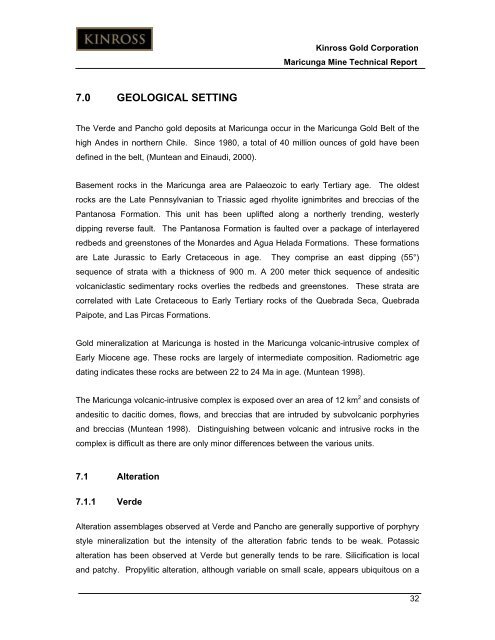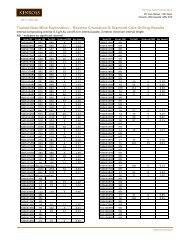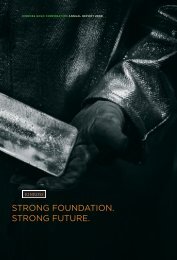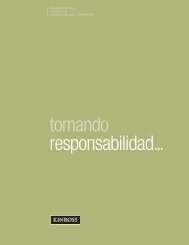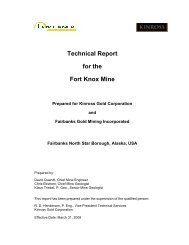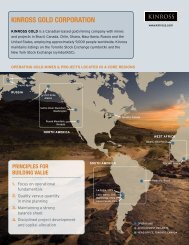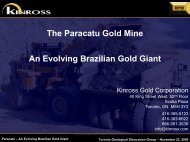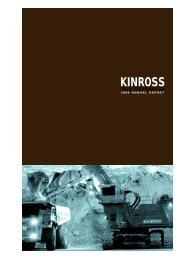Technical Report for the Maricunga Gold Mine - Kinross Gold
Technical Report for the Maricunga Gold Mine - Kinross Gold
Technical Report for the Maricunga Gold Mine - Kinross Gold
- No tags were found...
You also want an ePaper? Increase the reach of your titles
YUMPU automatically turns print PDFs into web optimized ePapers that Google loves.
<strong>Kinross</strong> <strong>Gold</strong> Corporation<strong>Maricunga</strong> <strong>Mine</strong> <strong>Technical</strong> <strong>Report</strong>7.0 GEOLOGICAL SETTINGThe Verde and Pancho gold deposits at <strong>Maricunga</strong> occur in <strong>the</strong> <strong>Maricunga</strong> <strong>Gold</strong> Belt of <strong>the</strong>high Andes in nor<strong>the</strong>rn Chile. Since 1980, a total of 40 million ounces of gold have beendefined in <strong>the</strong> belt, (Muntean and Einaudi, 2000).Basement rocks in <strong>the</strong> <strong>Maricunga</strong> area are Palaeozoic to early Tertiary age. The oldestrocks are <strong>the</strong> Late Pennsylvanian to Triassic aged rhyolite ignimbrites and breccias of <strong>the</strong>Pantanosa Formation. This unit has been uplifted along a nor<strong>the</strong>rly trending, westerlydipping reverse fault. The Pantanosa Formation is faulted over a package of interlayeredredbeds and greenstones of <strong>the</strong> Monardes and Agua Helada Formations. These <strong>for</strong>mationsare Late Jurassic to Early Cretaceous in age. They comprise an east dipping (55°)sequence of strata with a thickness of 900 m. A 200 meter thick sequence of andesiticvolcaniclastic sedimentary rocks overlies <strong>the</strong> redbeds and greenstones. These strata arecorrelated with Late Cretaceous to Early Tertiary rocks of <strong>the</strong> Quebrada Seca, QuebradaPaipote, and Las Pircas Formations.<strong>Gold</strong> mineralization at <strong>Maricunga</strong> is hosted in <strong>the</strong> <strong>Maricunga</strong> volcanic-intrusive complex ofEarly Miocene age. These rocks are largely of intermediate composition. Radiometric agedating indicates <strong>the</strong>se rocks are between 22 to 24 Ma in age. (Muntean 1998).The <strong>Maricunga</strong> volcanic-intrusive complex is exposed over an area of 12 km 2 and consists ofandesitic to dacitic domes, flows, and breccias that are intruded by subvolcanic porphyriesand breccias (Muntean 1998). Distinguishing between volcanic and intrusive rocks in <strong>the</strong>complex is difficult as <strong>the</strong>re are only minor differences between <strong>the</strong> various units.7.1 Alteration7.1.1 VerdeAlteration assemblages observed at Verde and Pancho are generally supportive of porphyrystyle mineralization but <strong>the</strong> intensity of <strong>the</strong> alteration fabric tends to be weak. Potassicalteration has been observed at Verde but generally tends to be rare. Silicification is localand patchy. Propylitic alteration, although variable on small scale, appears ubiquitous on a32


